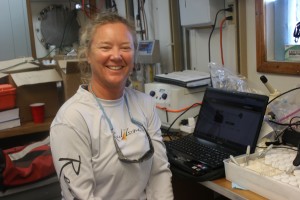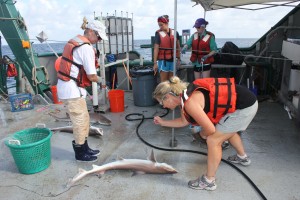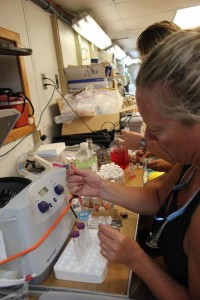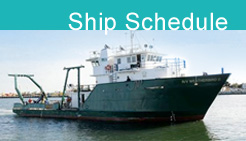Deep Sea Fish and Sediment Surveys in the Gulf
Meet C-IMAGE Environmental Forensics Scientist: Erin Pulster
Science is all about asking the right questions…and then carefully developing approaches that provide clear answers. The advent of new technology allows scientists to provide answers to particular questions with better and better resolution. In a nutshell, that is what the Environmental Laboratory for Forensics (ELF) at Mote Marine Laboratory does.
The fishes sampled during the C-IMAGE cruises are being analyzed biochemically by scientists at Mote Marine Laboratories in Sarasota, Florida. Scientist Erin Pulster is tirelessly processing tissue samples from over 300 fishes collected during this expedition. When a fish arrives on board, Erin swiftly draws a blood sample before the blood begins to coagulate. Then tissue samples from several organs are collected for later analysis at Mote Marine ELFS lab on shore. Each organ is being evaluated for possible DNA damage, while the blood is analyzed for fertility hormones and immune functions.
Erin works both on deck when fishes are collected and in the onboard lab. In the lab she carefully homogenizes (pulverizes) the organ tissues so the cells are isolated for preservation. The samples are frozen in liquid nitrogen, also called cryogenic preservation… now that sounds like forensics.
The ELF program was created by a team of scientists to use novel biomarkers to help answer pressing questions about effects of contaminants and other stressors. Biomarkers are specific physical or chemical responses that can be used to measure or indicate the effects on an organism due to some sort of stressor.
When used in conjunction with more traditional approaches, the careful and well-validated use of biomarkers can provide powerful insights…as is occurring through ELF’s efforts with snapper and other bony fishes, as well as sharks and even invertebrates exposed to oil in the Gulf disaster. ELF scientists are now using their unusual approach to better inform conservation efforts in a number of locations around the world.
The truth of the matter is that it is difficult to tease out all the environmental and human-related variables that could impact individuals and populations in the wild. The answers come slowly and with much effort, and scientists simply do not know at this point whether the Deepwater Horizon event could have impacted organisms exposed to the oil.
| Print article | This entry was posted by greely on August 20, 2012 at 12:56 am, and is filed under Oceanic Updates. Follow any responses to this post through RSS 2.0. You can leave a response or trackback from your own site. |




